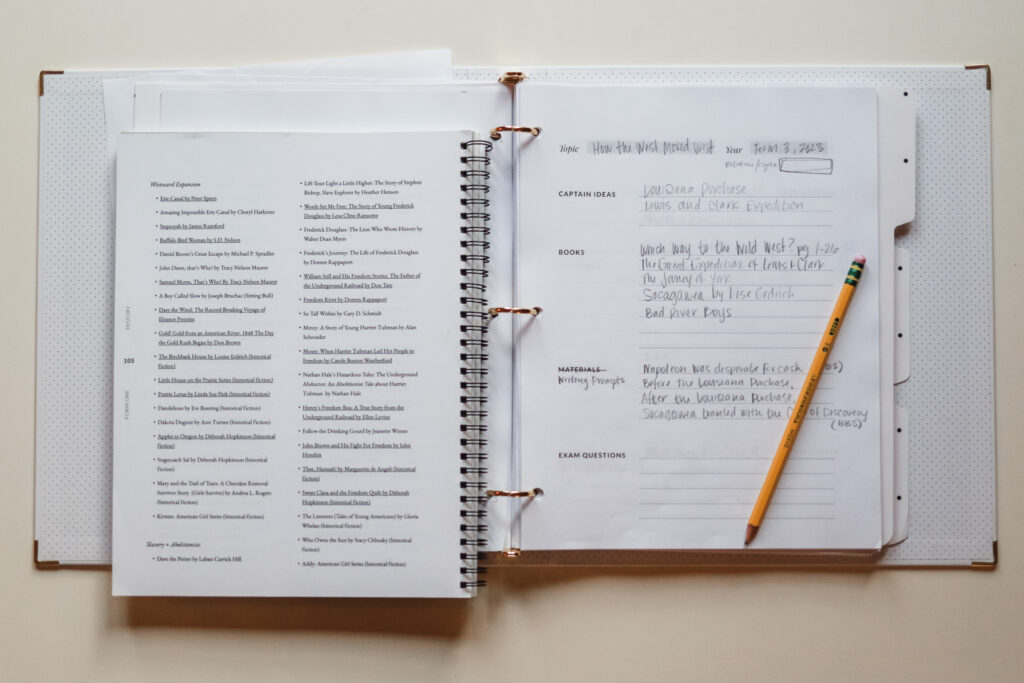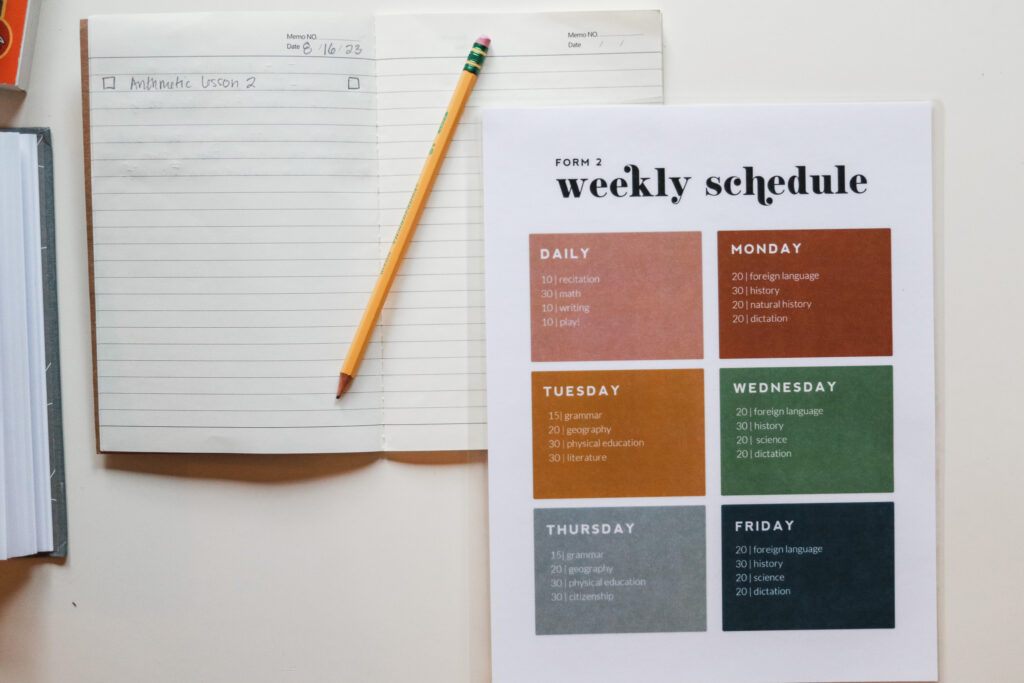You have no items in your cart. Want to get some nice things?
Go shopping
This post is a compilation of what I’ve learned from planning my family’s education over the past six years, plus my time as a homeschool student myself. It’s a simple, yet effective method that does not require expensive (or complicated) planners. It doesn’t require detailed spreadsheets or schedules. All you need is a simple calendar and notebook.
As a bonus I’m providing FREE downloadable planning sheets and weekly schedules so you have everything you need to begin planning your school year!
Principles
When I first started homeschooling I had beautiful planners where I planned out EVERYTHING.
I broke down every subject and curriculum to fit into a year. I had a spreadsheet with all the readings and activities planned out by week and even by day.
Then I actually started homeschooling, and things fell apart.
Daily lessons were dragged out way longer than I expected because my son’s attention was gone after five minutes, but I felt pressure to finish each lesson because if I didn’t, well then my perfect schedule would be interrupted and I’d have to rearrange my spreadsheet (gasp!).
School was not fun or enjoyable for either of us, and the stressful atmosphere was interfering with my son’s learning. I soon recognized the need for a more flexible plan, one that served me and my kids, not the other way around.
DO NOT become a servant to your schedule or your curriculum. Remember, they are there to serve YOU.
It was around this time that I was introduced to Charlotte Mason’s philosophy and methods. From her I learned that it is more developmentally appropriate to set a short amount of time for each subject instead of assigning a certain amount of material to complete. This ensures the child’s attention is held the entire time. At this age, most lessons are five to fifteen minutes, depending on the subject. The child works carefully and attentively for that short amount of time, and then the teacher (or mother) marks down what was accomplished. The important thing is to meet the child where he/she is at. If she can’t focus for five minutes, try three or four. Slowly increase time as your child’s ability to focus is strengthened.
After employing this method I was surprised at how much was accomplished in such a short amount of time– and with no whining, complaining or dawdling!
Instead of structuring content, structure time.
I learned that subjects can be divided into these two categories: content-based or skill-based. I call the content-based subjects “Gather” subjects because we can combine all kids in the family (or a form) and learn together . These subjects include: religion, history, literature, poetry, nature study, artist and composer study.
The skill-based subjects I refer to as “Line-Upon-Line” subjects because they are based on adding knowledge and skills incrementally and developmentally, line upon line. These are subjects that need to be studied individually, like math, language arts, and drawing. Contrary to popular belief, these subjects cannot be scheduled easily, as each individual child grows in understanding so differently. Once a child understands and masters a concept, like division, they are ready to move on to the next concept. If they do not master the concept and are hurried on to the next without a solid understanding, they are left with gaps. On the other hand, if a child is scheduled to learn a concept for two months, but masters it in three weeks, they are much more likely to become bored and resentful as they’re required to practice a concept they have already mastered.
Some subjects can be studied as a family, others are best learned individually.
With these principles in mind, I took on a completely different approach to planning. One that brings me peace, joy, and confidence.
Methods
Year
At the beginning of a school year I look at all the Gather (content-based) subjects. History and nature study are learned in four-year cycles, meaning that during their 12-year education my kids will encounter the same topics and time periods three times. For younger kids in form 1 (age 6-9 years) we only study American History. Once they enter form 2 (10-12 years) we begin Ancient and World History. I prefer to study one stream per term: Ancient Term 1, American Term 2, and World Term 3.
Year 1: 1000-1700 American and World, Ancient Near East and Egypt
Year 2: 1700-1800 American and World, Ancient Greece
Year 3: 1800-1900 American and World, Ancient Rome
Year 4: 1900-Present American and World, Medieval
I fill out the yearly sheet for the following subjects to give myself a broad view of the topics we’ll be studying, songs we’ll be singing, and poems we’ll be memorizing. These are the topics I plan out at the beginning for the year:
- Composer Study
- Artist Study
- Hymns/Folksongs
- Poet
- History
- Science
- Recitation (poems and scriptures)

Term
Terms are 12 weeks, and there are 3 terms per year. I’ve found it extremely helpful to do school for 5 weeks and take one week off. This week is a time for “reset” and rest. We make freezer meals, deep clean and organize the house, take field trips, and work on personal projects.
Once I have an idea of what topics I’ll study each term, I spend some time planning each one in a little more detail. I don’t plan out each lesson, or even each week, I simply plan out topics. I create a planning sheet for topics that we spend about 3-4 weeks digging into, like the Lewis and Clark Expedition for history or Reptiles in nature study. I designed planning sheets for this very purpose.
Books
After exploring book lists online and doing some of my own research at the library, I make a list of books I’d like to read.
Captain Ideas
After deciding on which books to read, I look over them and decide what are the “Captain Ideas” — in other words, why is this topic important to study?
Materials
I list any other materials we might use or reference, like maps, pictures of artifacts, paintings, or, in the case of nature study, plants or animals.
Questions
In this section I add narration and writing prompts, as well as questions to spark a family discussion. If your child generates their own questions while reading this is a good place to write them down. These can be used for Exam Questions.

Daily
Family Gather
Instead of planning out each week and day at the beginning of the year I practice “reverse planning.” This simply means to write down what we did accomplish at the end of the day in the time allotted for each subject. I write down how many pages we read in each book and tasks completed (like map questions). I do this in my JSTORY Large Weekly Planner.

Individual Learning
This year I’m trying a new method for planning out daily lessons. Originally, I kept a list of subjects to study each day of the week along with the amount of time to study them. However, my boys would constantly ask me what they needed to do or read for each subject. It took a lot of our time for me to explain which pages or look through the book to figure out where we left off. Then I learned about the notebook method from Sarah Mackenzie at Read Aloud Revival.
Here’s how it works: I have a simple notebook for each boy, a lined one for my son in form 2 and a blank one for my son in form 1.
Each night I refer to my weekly schedule and write down the subjects the child will study the next day, along with a specific assignment– e.g. read for 10 minutes, grammar lesson 9, read pages 22-30, copy one sentence, etc.
The key is to keep the list short, simple and realistic. The subjects I mark are the line-upon-line subjects that children must study individually. The content-based subjects, like history and poetry, are studied as a family during our Gather hour.
When a child completes a task they mark the left square. They must bring their completed work to me, or narrate to me about what they read, so I can look it over and mark it complete (the right square).

During Quiet Reading Time (QRT) the child chooses books to read from a basket that I’ve stocked with books related to the topics we’re studying as a family (history, nature study, geography, music, and art). This gives them the opportunity to dig deeper into subjects that peaked their interest during our Gather time.
On the opposite page my ten year old son writes a narration based on what he read in his Quiet Reading Time. Alternatively, younger children can draw a picture of something they learned and dictate their narration to you.
If a child doesn’t complete a lesson or reading, you simply move it to the next day.
And that’s it! My simple and realistic method of planning a home education. If you have any questions please don’t hesitate to leave a comment below.
Resources
Downloads
You can download the planning sheets and weekly schedules below:
